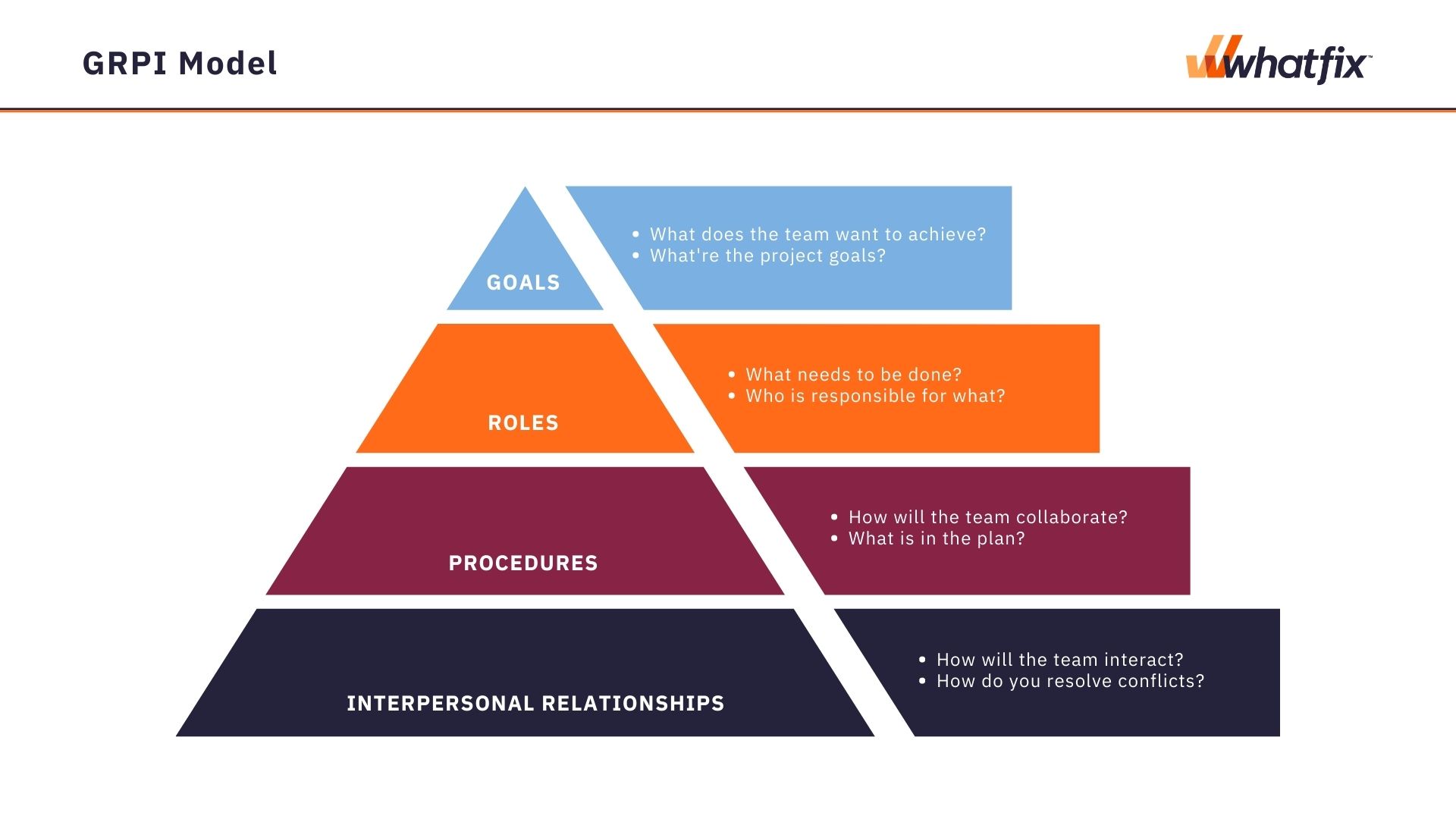

Disha Gupta


Businesses at all scales rely on the efficient collaboration of high-performing teams to thrive. Team performance, however, isn’t simply a matter of talent. Many of us learned this way back in middle school when we were introduced to the concept of group projects.
Teams need structure and an understanding of shared goals to guide their members through development and drive performance. Over the years, the GRPI model has emerged as an effective framework for enabling teams to align their work, overcome challenges, and achieve success. Implementing a GRPI model can help teams embrace creativity and innovation to reach their full potential.
GRPI is an acronym that stands for Goals, Roles, Processes, and Interpersonal relationships. The GRPI model is an approach to team development that was introduced in the early 1970s by Richard Beckard, an organizational development expert and professor at MIT.
This model provides organizational leaders with a comprehensive framework for effective and efficient teamwork in the workplace. HR departments can use this framework to structure project teams and diagnose and resolve any dysfunction that may arise.

Understanding the four components of the GRPI model helps leaders guide their teams toward success, pinpoint operational issues, and work with team members to rectify them.
Every project needs an ultimate purpose and set of goals all its team members share.
In fact, team conflicts stem from a lack of understanding of project goals. Teams should set and document clear goals from the beginning of the project or initiative by defining the outcomes they expect to achieve.
These goals must be SMART (specific, measurable, achievable, and relevant), and be understood within the context of the project at hand, the line of business, and the organization.
As the project progresses, team members can refer back to these overarching goals to keep the project on track.
Questions managers, team leads, and individual contributors should ask themselves include:
Once the purpose and goals of the project are defined and understood, the next step is to determine what exactly needs to be done to achieve those goals and outline the team’s structure, defining the roles and responsibilities of all team members.
Clear delineation of responsibilities lessens the probability of conflict and keeps people productive and oriented toward achieving goals.
This component should also be returned throughout the project. Leaders should check in with their team periodically to gauge how team members see their roles, and clarifying differences in responsibility can go a long way toward maintaining boundaries and promoting a positive employee experience.
All team members should be aware of the authority their role provides them and their specific responsibilities related to the project’s goals.
The following are examples of questions to ask and answers you should document in relation to roles:
After these structural details are set, team leaders need to outline a plan and provide a clear path toward meeting the team’s goals and objectives.
Without a plan, team members tend to struggle and try to determine their path forward, which may cause problems in decision-making, communication, and coordination of work.
Throughout the project, managers should monitor processes to ensure that they are working correctly and that all participating team members collaborate to share the workload according to their previously-set responsibilities.
Process-related questions to ask, consider, and document include:
The final element of the GRPI model is interpersonal relationships.
Developing strong interpersonal relationships between team members is critical to a team’s success. Team members have different personalities, outlooks, learning styles, and working styles, so some maintenance may be required to keep things running smoothly.
Leaders can promote good working relationships by establishing conflict management processes, encouraging clear and respectful communication, and promoting a constant flow of constructive feedback.
Building solid relationships promotes trust and leaves room for flexibility and independent achievement with the assurance that all work is being done toward a common goal.
Questions team leaders should ask to identify and overcome interpersonal team issues include:
The GRPI model provides a map for leaders to improve their team’s performance and un-stick them from problematic situations.
The model provides a number of benefits to teams and the larger organizations they work within.
Establishing clear goals from the outset ensures that team members can work cohesively toward their goals, avoiding redundancy and confusion that can slow things down.
The GRPI model emphasizes the importance of structure to empower team leaders to set up efficient workflows and communication channels, as well as make decisions to keep the team working efficiently. This also enables leaders to respond to and resolve challenges as they arise quickly.
The GRPI model’s emphasis on building interpersonal relationships within the structure of a team’s roles and responsibilities improves the level of communication between team members and promotes collaboration.
When all team members understand how their work contributes to the overall goals of the team, tasks can be completed efficiently, without conflict or confusion.
Well-defined roles and responsibilities keep team members in check and reduce ambiguity when issues arise. This clarity increases efficiency in problem-solving and holds employees accountable for their duties as the team works toward its goals.
By situating a team’s goals within the organization’s mission and goals in addition to lower-level objectives, teams can position themselves for success at various levels.
This alignment helps project leaders ensure that their team’s work delivers outcomes that match the company’s long-term strategic plans.
When team members understand how their work contributes to the organization’s success, they tend to be more engaged and motivated to achieve team goals, improving employee performance.
The GRPI model is considered an excellent starting point, rather than an end-all-be-all, framework for team performance.
While it offers valuable guidance for team organization and development, the GRPI model has two significant limitations. Those two major shortcomings include:
The GRPI model doesn’t account for how a team might vary in operations or performance in the long run, so it doesn’t necessarily apply to a team’s developmental issues.
This also means the GRPI model lacks flexibility, which presents challenges in dynamic circumstances.
For teams operating in uncertain environments, team leaders may need to return to the model regularly to reconsider and adjust the team’s goals, roles, processes, and interpersonal relationships.
The GRPI model views teams as rational entities rather than understanding the individuals that teams are made up of, who make emotional connections over time.
This places limitations on the model in terms of development for individual employees. Employees’ unique growth trajectories and career goals are essential to employee experience, engagement, and productivity.
It’s essential for team leaders and managers to remember this and incorporate these individualistic priorities into a team’s framework, alongside the GRPI model.
While there are many details to consider when assembling new teams and optimizing existing ones, the GRPI model can be easily implemented by the steps laid out below:
Team members and their leaders must understand the current state of affairs within the team. Start out by gathering the team to discuss where things stand related to the four components of the GRPI model.
During this discussion, work together to lay out the team’s main goals, and metrics used to measure success, and determine how it all relates to organizational goals.
Ask employees to describe their roles, duties, and approaches to communication and coordination. Finally, take the time to talk through aspects of interpersonal relationships, like showing trust and respect as well as managing conflict.
Once everybody understands the team’s current state, it’s time to define the team’s goals and objectives. Set SMART goals and lay out the smaller milestones that need to happen along the way. At the end of this step, take the time to document details and disseminate the information to the entire team.
Next, identify the different roles necessary to meet the established goals. If these do not match up with the existing team structure, some shuffling may be required.
Define each employee’s role on the team and be sure to include their specific tasks and level of authority to make different types of decisions. Once roles have been defined, take a step back to pinpoint any gaps or overlaps to avoid any imbalance in the distribution of work or responsibilities.
Now it’s time to determine how team members will function within their roles to achieve team goals. Team leaders should establish decision-making processes, define workflows, and institute clear channels for communication.
Once these procedures are outlined, leaders should regularly review these processes to continually improve efficiency and team effectiveness.
As things get rolling, team leaders must encourage open and transparent communication among team members to build trust and create a supportive environment. Leaders should encourage respectful communication, active listening, and continual sharing of feedback across the team.
Conflict should be handled promptly and with consideration for each team member’s experience. By building a team culture that promotes inclusivity, transparency, and accountability, employees will have more positive experiences and be better equipped to work productively.
Once the team’s structure and processes are fleshed out, team leaders should construct a plan for implementation.
Like most initiatives, the GRPI model should have support from organizational leaders and awareness from team members before it is put in place. Depending on how much change needs to happen, it may be beneficial for team members if changes are implemented more gradually.
Throughout and following implementation, team leaders must take steps to communicate and engage with their teams. This reduces tension and improves understanding to allow for a more positive employee experience and future success for the team.
Part of this communication should also include the solicitation of feedback from team members so leaders can address challenges and pinpoint areas of the plan that need improvement.
As the team moves forward toward its goals, team leaders should continuously provide the support and resources members need to fulfill their responsibilities, develop interpersonal relationships with their peers, and move toward their individual and team-wide goals.
Leaders should check in regularly to determine whether employees’ needs are being met and adjust the team’s processes accordingly.
Following the implementation of the GRPI model, the team’s progress should be monitored based on the measurements of success laid out in the “Goals” stage.
As data comes in, leaders should return to the model to determine which aspects of the team’s structure and processes contribute to positive or negative outcomes.
The GRPI model empowers organizations to build teams that perform to the highest standards and overcome challenges when they arise. This model provides a valuable jumping-off point for team leaders to develop the structure of their teams, promote collaboration, and ensure improved team performance and outcomes.
Implementing a DAP, such as Whatfix, help organizations provide better training and support to their employees through in-app guidance and self-help support.
This enhances end-user proficiency, reduces support requests, and fosters a self-sufficient and empowered workforce. A DAP’s real-time assistance, personalized experiences, and comprehensive resources contribute to a smoother software adoption process and promote productivity and efficiency within the organization.
Software clicks better with Whatfix's digital adoption platform
Enable your employees with in-app guidance, self-help support, process changes alerts, pop-ups for department announcements, and field validations to improve data accuracy.
Thank you for subscribing!